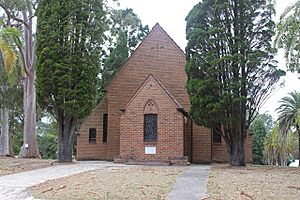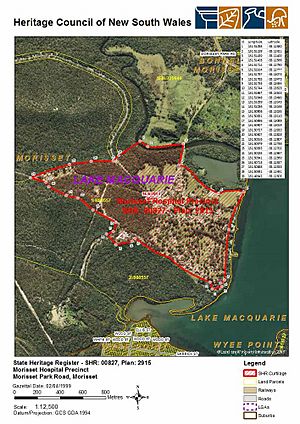Morisset Hospital facts for kids
Quick facts for kids Morisset Hospital |
|
|---|---|
 |
|
| Location | Morisset Park Road, Morisset, Greater Newcastle, New South Wales, Australia |
| Built | 1906–1959 |
| Architect | NSW Government Architect's Office |
| Owner | NSW Department of Health |
| Official name: Morisset Hospital Precinct; Ward; Medical Records; Ambulance Training; Psych. Rehab Building | |
| Type | state heritage (complex / group) |
| Designated | 2 April 1999 |
| Reference no. | 827 |
| Type | Hospital |
| Category | Health Services |
| Builders | NSW Department of Public Works |
| Lua error in Module:Location_map at line 420: attempt to index field 'wikibase' (a nil value). | |
Morisset Hospital is a special hospital in Morisset, New South Wales, Australia. It was built a long time ago, starting in 1906. This hospital was designed by the New South Wales Government Architect's Office. It is an important historical place and is listed on the New South Wales State Heritage Register. This means it's protected because of its history and special features.
Contents
History of Morisset Hospital
How the Hospital Started
Morisset Hospital is named after a soldier called James Morisset. He was an important person in the early history of Australia.
In 1900, the government decided to set aside a large area of land near Lake Macquarie. This land was chosen to build a hospital for people who needed mental health care. The plan to build Morisset Hospital was approved in 1901.
Work on the hospital began in 1906. At first, only a few staff and patients lived in tents while the land was cleared. The first things built were a jetty (a pier for boats) and a dam. Building materials were brought across the lake by boat.
Early Years and Growth
In 1907, George Edwards became the first manager. He helped get the land ready and build roads. The main road leading to Morisset town, called "The Avenue," was built to help with access.
The first main patient building, Ward 1, and a Recreation Hall started being built in 1908. The first patients arrived on May 9, 1909. Ward 1 officially opened on September 6, 1909, with 78 male patients. More buildings were quickly under construction.
By 1910, the hospital had 157 male patients. Some patients lived in temporary dormitories made of wood frames and canvas. The manager's house was also built around this time.
In 1911, a cricket oval, poultry yards, and gardens were finished. The number of male patients grew to 243 in 1912, then 288 in 1913, and 375 in 1914. A full-time doctor, Dr. Samson, started working at the hospital in 1912.
Challenges and Changes
Building new parts of the hospital mostly stopped during World War I. However, a fishing fleet was started, and the main store building was finished in 1916. By 1918, there were 484 male patients, which was more than the hospital could comfortably hold. Even with a new ward opening in 1920, overcrowding was still a big problem.
In 1930, a special area was set aside for a hospital for patients who needed more secure care. This unit started in 1933. By then, 672 men were living at Morisset Hospital.
The first female patients and nurses arrived in March 1934. New wards for male patients opened in March 1938. World War II caused another pause in construction because there wasn't enough money. A serious drought in 1939 led to a water shortage, so an emergency water supply had to be built.
The hospital's chapel opened in August 1957, and a dairy farm started in July 1962. By 1963, the hospital had a large patient population of 1490 people.
Modern Times
In 1965, male and female patient areas started to be combined. More patients were able to leave the hospital, which helped reduce overcrowding.
By 1970, the number of patients was going down. This was because new medications and treatment programs were available. Also, community attitudes towards mental health were changing. In the early 1970s, patients from other smaller hospitals were moved to Morisset. Patient work groups, where patients helped with tasks around the hospital, stopped in 1974.
In 1985, the hospital was split into two main parts: Psychiatric Services and Developmental Disability. Some wards were closed. In the early 1990s, more wards closed or were taken down. A new, very secure unit for forensic psychiatry was built where some old wards used to be.
The new Morisset Multipurpose Centre opened in November 2004.
What Morisset Hospital Looks Like
The Morisset Hospital site is very large, covering about 1,244 hectares (about 4.8 square miles). It has almost 100 historic buildings. The hospital is located about 3 kilometers (about 1.8 miles) southeast of Morisset town, facing east towards Lake Macquarie.
The hospital grounds have two main parts. There's a large area for the general hospital, which is beautifully landscaped and slopes down to the lake. Then there's a smaller area for the special unit that needed more secure care. This part is separate and has walls, like an old city.
The hospital also had farms located north of Duck Hole Creek. The entire site stretches from the railway line in the west to Charles Avenue in the east. It goes north to Fishery Point Road and about half a kilometer south of the secure psychiatry wards. Lake Macquarie forms a natural boundary on the eastern side.
The eastern side of the hospital grounds is next to the Lake Macquarie State Recreation Area. This area is managed by the National Parks and Wildlife Service.
Important Buildings and Areas
The hospital area includes many different buildings. Some of these are:
- MS-12 Wards 5 & 6
- MS-13 Ward 9, Clinical Department
- MS-14 Ward 10
- MS-15 The Chapel
- MS-16 Recreation Hall, built in 1909
- MS-17 The Main Store
- MS-19 Residence no.1
- MS-20 Ward 17, General Psychiatry
- MS-23 Ward 12
- MS-24 Residence no.3
- MS-26 Cottage Row Residences (numbers 16 to 21)
Nature and Trees
The hospital site is surrounded by thick bushland, which is either natural or has grown back. There are still native plants and trees here. Near the lake, you can see many Casuarina trees. Further inland, you'll find Forest Red Gum (Eucalyptus tereticornis) and Rough-barked Apple Gum trees. Some of these trees might even be older than the hospital itself! On higher ground, there are Scribbly Gum and Bloodwood forests.
Over the years, many different types of trees and palms have been planted on the site. There are about 80 different kinds of trees and palms. The oldest planted trees are around the Recreation Hall and Chapel, and along some of the roads like Palm Way.
Some very old trees on the northern side of the Recreation Hall and southern end of Eucalyptus Drive were likely there before the hospital was built. The site has many mature trees, which are found near buildings, staff areas, open spaces, and along roads.
The Cemetery
There is a cemetery linked to the hospital, located off Nentoura Road. It's in a quiet bushland area. The oldest headstone there is from 1911. The cemetery has different sections for various religions. Many patients from Morisset Hospital are buried in unmarked graves on the eastern side of the cemetery.
There is a special Memorial Wall made of grey granite at the cemetery. It has a black granite plaque dedicated to the former Morisset Hospital patients who are buried in unmarked graves. Families can also add individual memorials for their relatives here.
Heritage Listing
The Morisset Hospital Precinct was officially added to the New South Wales State Heritage Register on April 2, 1999. This listing helps protect the hospital and its grounds as an important part of history.



